1996 CADILLAC FLEETWOOD towing
[x] Cancel search: towingPage 178 of 306
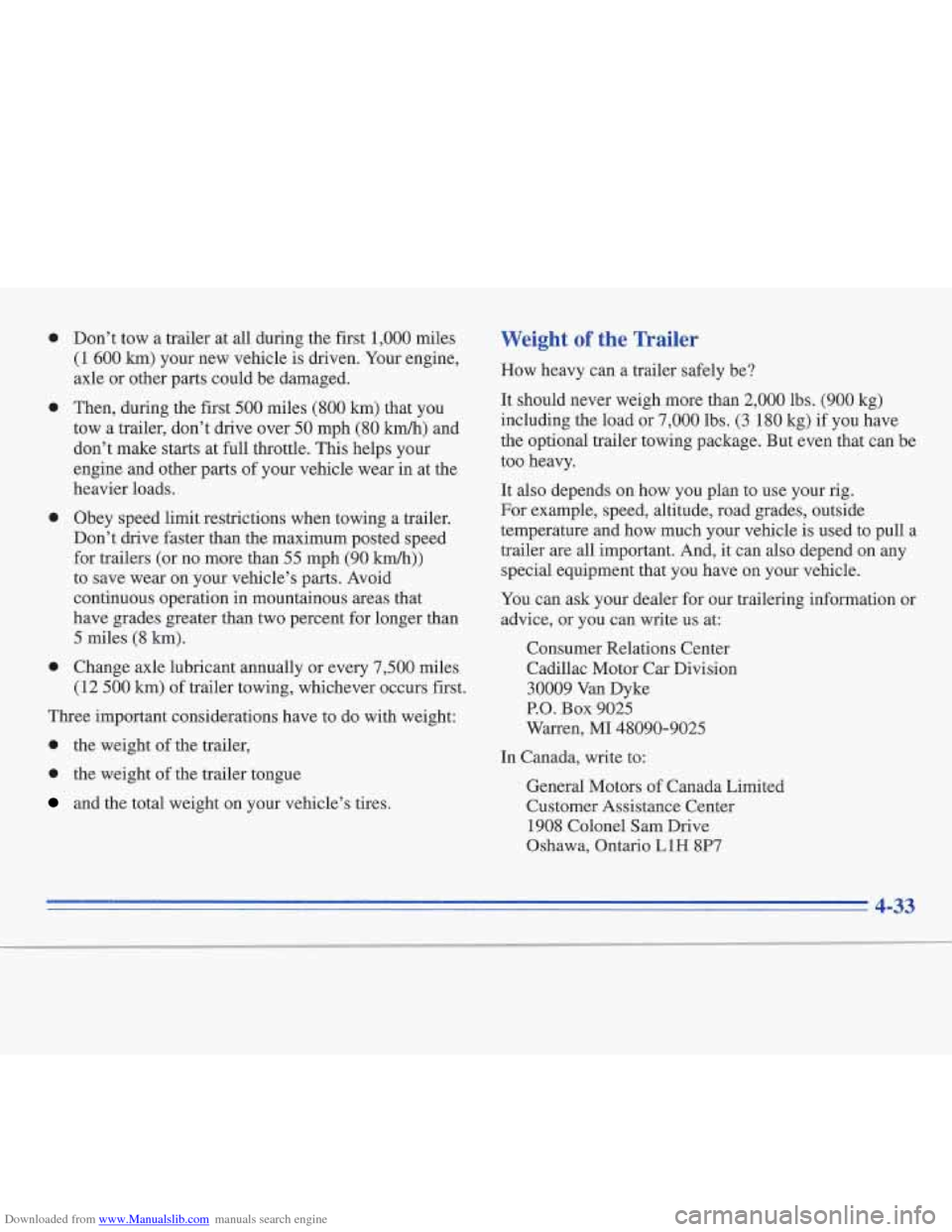
Downloaded from www.Manualslib.com manuals search engine 0
0
0
0
Don’t tow a trailer at all during the first 1,000 miles
(1
600 km) your new vehicle is driven. Your engine,
axle or other parts could be damaged.
Then, during the first
500 miles (800 km) that you
tow a trailer, don’t drive over
50 mph (80 km/h) and
don’t make starts at full throttle. This helps your
engine and other parts
of your vehicle wear in at the
heavier loads.
Obey speed limit restrictions when towing a trailer.
Don’t drive faster than the maximum posted speed
for trailers (or no more than
55 mph (90 km/h))
to save wear on your vehicle’s parts. Avoid
continuous operation in mountainous areas that
have grades greater than two percent for longer than
5 miles (8 km).
Change axle lubricant annually or every 7,500 miles
(12
500 km) of trailer towing, whichever occurs first.
Three important considerations have to do with weight:
0 the weight of the trailer,
0 the weight of the trailer tongue
and the total weight on your vehicle’s tires.
Weight of the Trailer
How heavy can a trailer safely be?
It should never weigh more than 2,000 lbs.
(900 kg)
including the load or 7,000 lbs. (3 180 kg) if you have
the optional trailer towing package. But even that can be
too heavy.
It also depends on how you plan to use your rig.
For example, speed, altitude, road grades, outside
temperature and how much your vehicle is used
to pull a
trailer are all important. And, it can also depend
on any
special equipment that
you have on your vehicle,
You can ask your dealer for our trailering information or
advice, or you can write us at:
Consumer Relations Center
Cadillac Motor Car Division
30009 Van Dyke
P.O. Box 9025
Warren, MI 48090-9025
In Canada, write to:
General Motors of Canada Limited
Customer Assistance Center 1908 Colonel Sam Drive
Oshawa, Ontario L1
H 8P7
4-33
Page 179 of 306
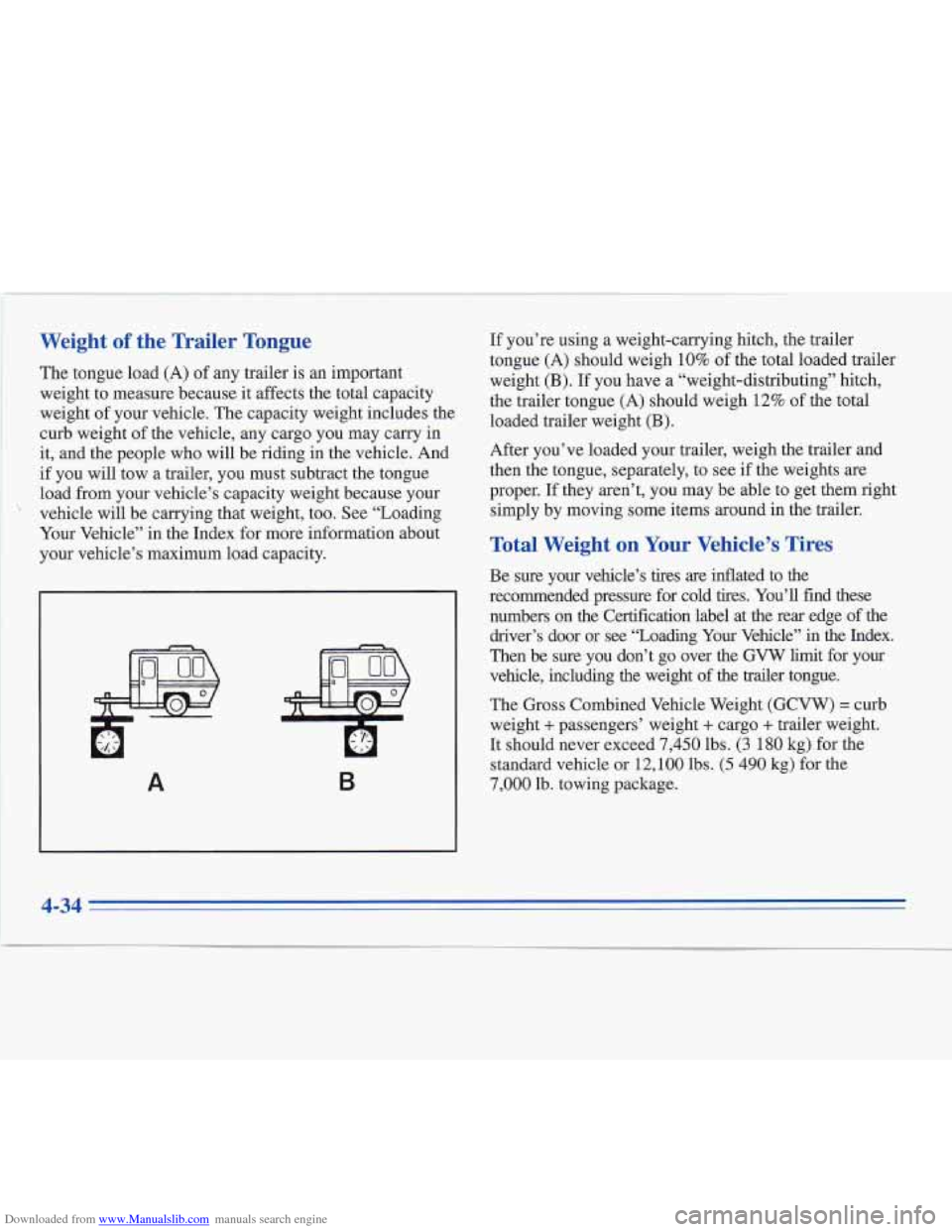
Downloaded from www.Manualslib.com manuals search engine Weight of the Trailer Tongue
The tongue load (A) of any trailer is an important
weight to measure because it affects the total capacity
weight of your vehicle.
The capacity weight includes the
curb weight of the vehicle, any cargo you may carry in
it, and the people who will be riding in the vehicle. And
if you will tow a trailer, you must subtract the tongue
load from your vehicle’s capacity weight because your
vehicle will be carrying that weight, too. See “Loading
Your Vehicle” in the Index for more information about
your vehicle’s maximum load capacity.
B A
If you’re using a weight-carrying hitch, the trailer
tongue
(A) should weigh 10% of the total loaded trailer
weight
(B). If you have a “weight-distributing” hitch,
the trailer tongue
(A) should weigh 12% of the total
loaded trailer weight
(B).
After you’ve loaded your trailer, weigh the trailer and
then the tongue, separately, to see if the weights
are
proper. If they aren’t, you may be able to get them right
simply by moving some items around in the trailer.
Total Weight on Your Vehicle’s Tires
Be sure your vehicle’s tires are inflated to the
recommended pressure for cold tires. You’ll find these numbers on the Certification label at the
rear edge of the
driver’s door or
see “Loading Your Vehicle” in the Index.
Then be sure you don’t go over
the GVW limit for your
vehicle, including the weight
of the trailer tongue.
The Gross Combined Vehicle Weight (GCVW)
= curb
weight
+ passengers’ weight + cargo + trailer weight.
It should never exceed 7,450 lbs.
(3 1 SO kg) for the
standard vehicle
or 12,100 lbs. (5 490 kg) for the
7,000 lb. towing package.
4-34
Page 181 of 306
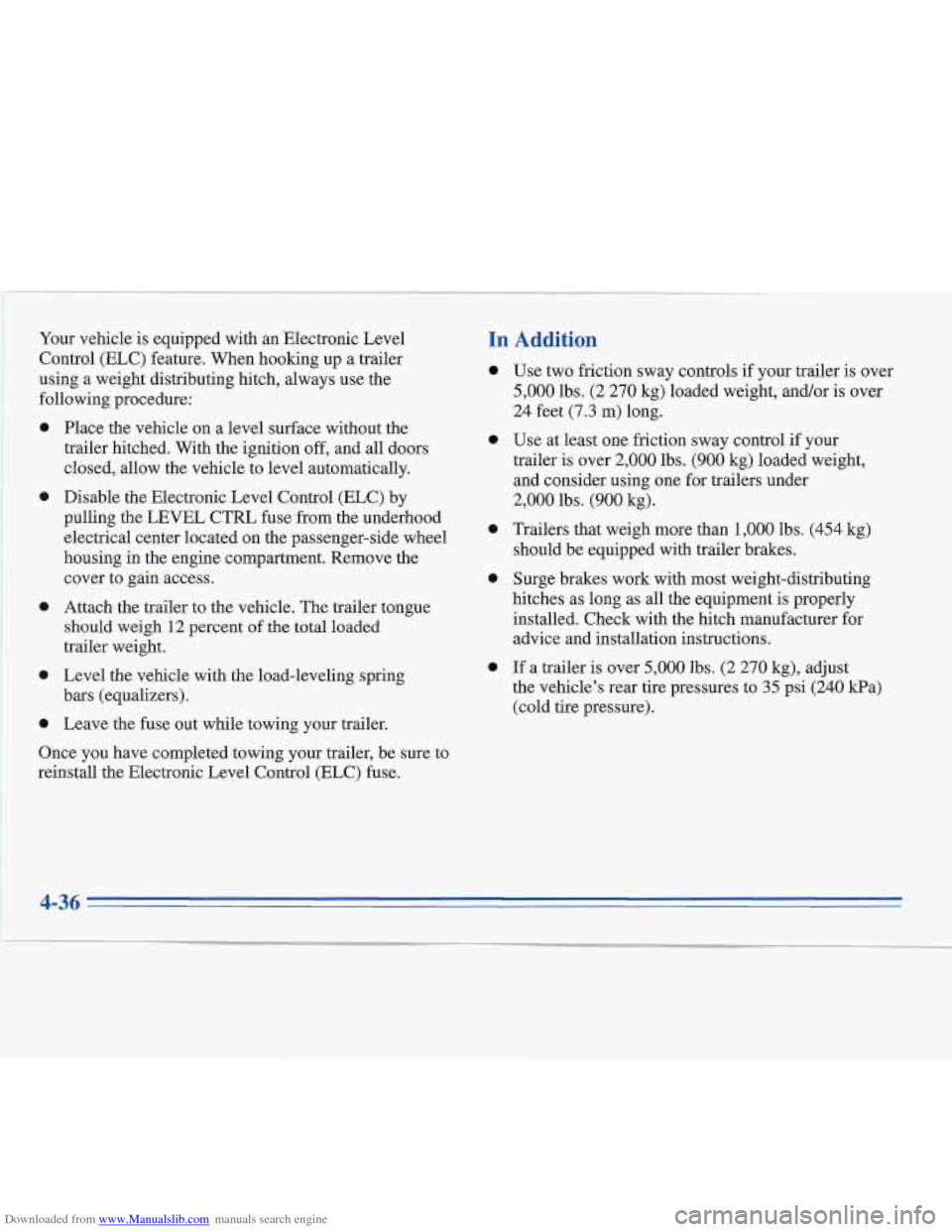
Downloaded from www.Manualslib.com manuals search engine Your vehicle is equipped with an Electronic Level
Control (ELC) feature. When hooking up a trailer
using a weight distributing hitch, always use the
following procedure:
a
a
a
a
0
Place the vehicle on a level surface without the
trailer hitched. With the ignition off, and all doors
closed, allow the vehicle to level automatically.
Disable the Electronic Level Control (ELC) by
pulling the LEVEL CTRL fuse from the underhood
electrical center located on the passenger-side wheel
housing in the engine compartment. Remove the
cover to gain access.
Attach the trailer to the vehicle. The trailer tongue
should weigh
12 percent of the total loaded
trailer weight.
Level the vehicle with the load-leveling spring
bars (equalizers).
Leave the fuse out while towing your trailer.
Once you have completed towing your trailer, be sure
to
reinstall the Electronic Level Control (ELC) fuse.
In Addlon
a
a
a
0
0
Use two friction sway controls if your trailer is over
5,000 lbs. (2 270 kg) loaded weight, and/or is over
24 feet (7.3 m) long.
Use at least one friction sway control if your
trailer is over
2,000 lbs. (900 kg) loaded weight,
and consider using one for trailers under
2,000 lbs.
(900 kg).
Trailers that weigh more than
1,000 lbs. (454 kg)
should be equipped with trailer brakes.
Surge brakes work with most weight-distributing
hitches as long as all the equipment is properly
installed. Check with the hitch manufacturer for
advice and installation instructions.
If a trailer is over 5,000 lbs. (2 270 kg), adjust
the vehicle's rear tire pressures to
35 psi (240 Pa)
(cold tire pressure).
4-36
Page 182 of 306

Downloaded from www.Manualslib.com manuals search engine Safety Chains Trailer Wiring Harness
You
should always attach chains between your vehicle
and your
trailer. Cross the safety chains under the tongue
of the trailer
so that the tongue will not drop to the road
if it becomes separated from the hitch. Instructions
about safety chains may be provided by the hitch
manufacturer or by the trailer manufacturer. Follow the
manufacturer’s recommendation for attaching safety
chains and do not attach them to the bumper. Always
leave just enough slack
so you can turn with your rig.
And, never allow safety chains to drag on the ground.
Trailer Brakes
If your trailer weighs more than 1,000 lbs. (450 kg)
when loaded,
it needs to be equipped with adequate
brakes. Be sure to read and follow the instructions
for
the trailer brakes so you’ll be able to maintain
them properly.
Because you have anti-lock brakes, do not
try to tap into
your vehicle hydraulic brake system.
If you do, both
brake systems won’t work well, or at all.
If your Fleetwood is equipped with the heavy duty
trailering option, a five-wire trailering harness is
located in the trunk. You may have to have it wired
to your vehicle.
These trailer harness color codes should be followed
when connecting to your trailer:
0 White: Direct Trailer Ground for Trailer Lamps
0 Brown: Parking Lamps
Yellow: Left Turn and Stoplamps
Dark Green: Right Turn and Stoplamps
Dark Blue: Auxiliary Circuit
Driving with a Trailer
Towing a trailer requires a certain amount of experience.
Before setting out for
the open road, you’ll want to get
to know your rig. Acquaint yourself with the feel of
handling and braking with the added weight of the
trailer. And always keep
in mind that the vehicle you are
driving is now a good deal longer and not nearly as
responsive as your vehicle is by itself.
Page 184 of 306
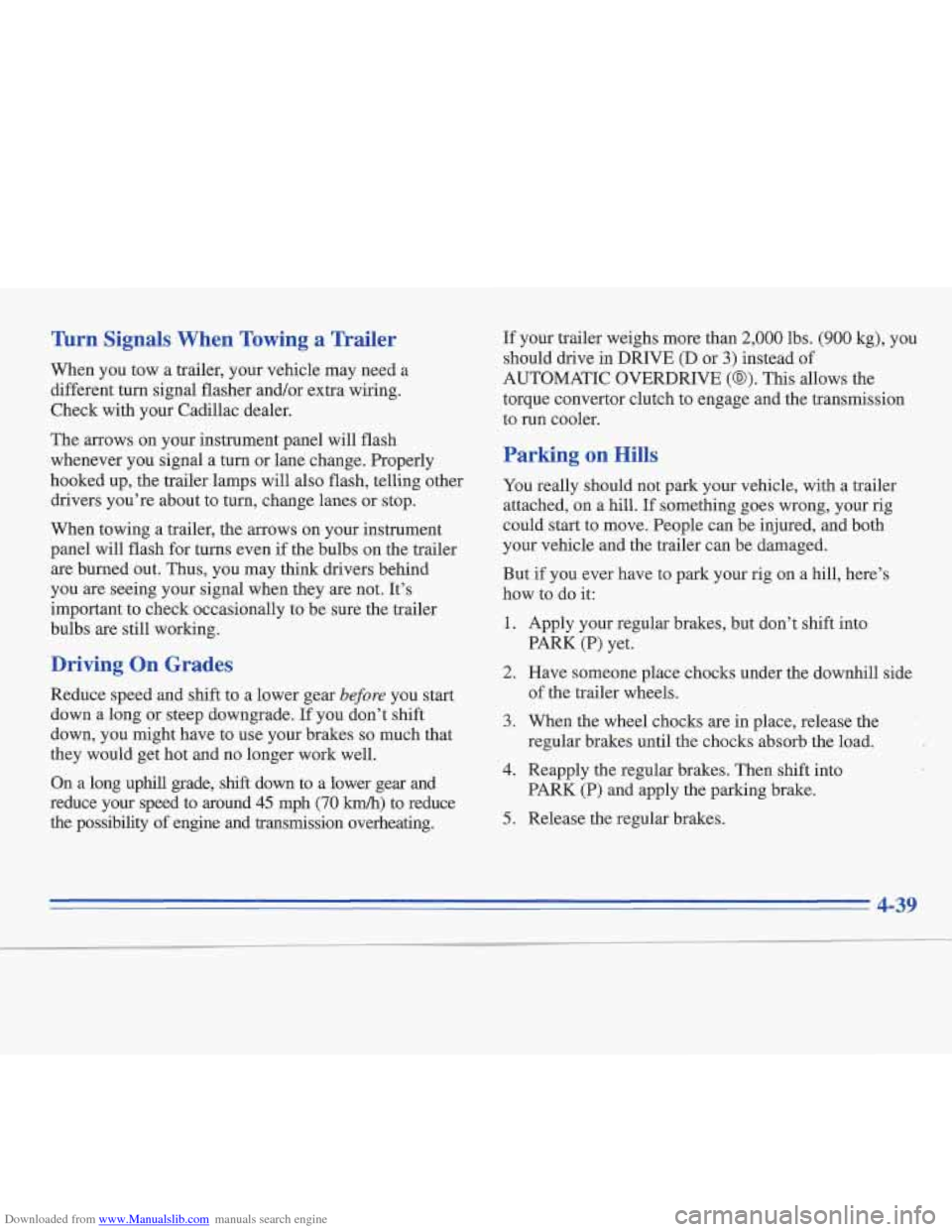
Downloaded from www.Manualslib.com manuals search engine Turn Signals When Towing a Trailer
When you tow a trailer, your vehicle may need a
different turn signal flasher and/or extra wiring.
Check with your Cadillac dealer.
The arrows on your instrument panel will flash
whenever you signal a turn or lane change. Properly
hooked up, the trailer lamps will also flash, telling other
drivers you’re about to turn, change lanes or stop.
When towing a trailer, the arrows on your instrument
panel will flash for turns even if
the bulbs on the trailer
are burned out. Thus, you may think drivers behind
you are seeing your signal when they are not. It’s
important to check occasionally to be sure the trailer
bulbs
are still working.
Driving On Grades
Reduce speed and shift to a lower gear before you start
down a long or steep downgrade. If you don’t shift
down, you might have to use your brakes
so much that
they would get hot and no longer work well.
On a long uphill grade,
shift down to a lower gear and
reduce your speed to around
45 mph (70 km/h) to reduce
the possibility of engine and transmission overheating.
If your trailer weighs more than 2,000 lbs. (900 kg), you
should drive in DRIVE
(D or 3) instead of
AUTOMATIC OVERDRIVE (@). This allows the
torque convertor clutch to engage and the transmission
to run cooler.
Parking on Hills
You really should not park your vehicle, with a trailer
attached, on a hill. If something goes wrong, your rig
could start to move. People can be injured, and both
’
your vehicle and the trailer can be damaged.
But if you ever have to park your rig on a hill, here’s
how to do
it:
1. Apply your regular brakes, but don’t shift into
2. Have someone place chocks under the downhill side
PARK
(P) yet.
of the trailer wheels.
3. When the wheel chocks are in place, release the
regular brakes until the chocks absorb the load.
4. Reapply the regular brakes. Then shift into
PARK (P) and apply the parking brake.
5. Release the regular brakes.
Page 185 of 306

Downloaded from www.Manualslib.com manuals search engine ’men You Are Ready to Leave After
Parking on a Hill
1. Apply your regular brakes and hold the pedal down
while you:
Start your engine;
Shift into a gear; and
Be sure the parking brake has released.
2. Let up on the brake pedal.
3. Drive slowly until the trailer is clear of the chocks.
4. Stop and have someone pick up and store the chocks.
Engine Cooling When Trailering
Your cooling system may temporarily overheat during
severe operating conditions such as:
Climbing grades steeper than four percent at
temperatures above
90°F (32°C) with a loaded
vehicle and trailer.
Stopping after high-speed driving.
Idling for long periods in stop-and-go traffic.
Maintenance When Trailer Towing
Your vehicle will need service more often when you’re
pulling a trailer. See the Maintenance Schedule for more
on this. Things that
are especially important in trailer
operation are automatic transmission fluid (don’t
overfill), engine oil, axle lubricant, belt, cooling system and brake adjustment. Each of these is covered in this
manual, and the Index will help you find them quickly.
If you’re trailering, it’s a good idea to review these
sections before
you start your trip.
Check periodically to see that all hitch nuts and bolts
are tight.
4-40
Page 192 of 306

Downloaded from www.Manualslib.com manuals search engine Towing Your Vehicle
Try to have a Cadillac dealer or a professional towing
service tow your Fleetwood. They can provide the right
equipment and know how to tow your vehicle without
damage. See “Roadside Assistance” in the Index.
If your vehicle has been changed or modified since it
was factory new
by adding aftermarket items like fog
lamps, aero skirting, or special tires and wheels, these
instructions and illustrations may not be correct.
Before you do anything, turn on the hazard
warning flashers.
When you call, tell the towing service:
That your vehicle can be towed from the front or rear
with wheel lift equipment.
That your vehicle has rear-wheel drive.
The make, model and year of your vehicle.
Whether you can still move the shift lever.
If there was an accident, what was damaged.
When
the towing service arrives, let the tow operator know
that
this manual contains detailed towing instructions and
illustrations. The operator may want to see them.
To help avoid injury to you or others:
Never let passengers ride in a vehicle that is
Never tow faster than safe or posted speeds.
Never tow with damaged parts not
fuIly secured.
Never get under your vehicle after it has
been lifted by the tow truck.
Always secure the vehicle on each side with
separate safety chains when towing it.
Never use J-hooks. Use T-hooks instead.
being towed.
- 5-7
Page 193 of 306
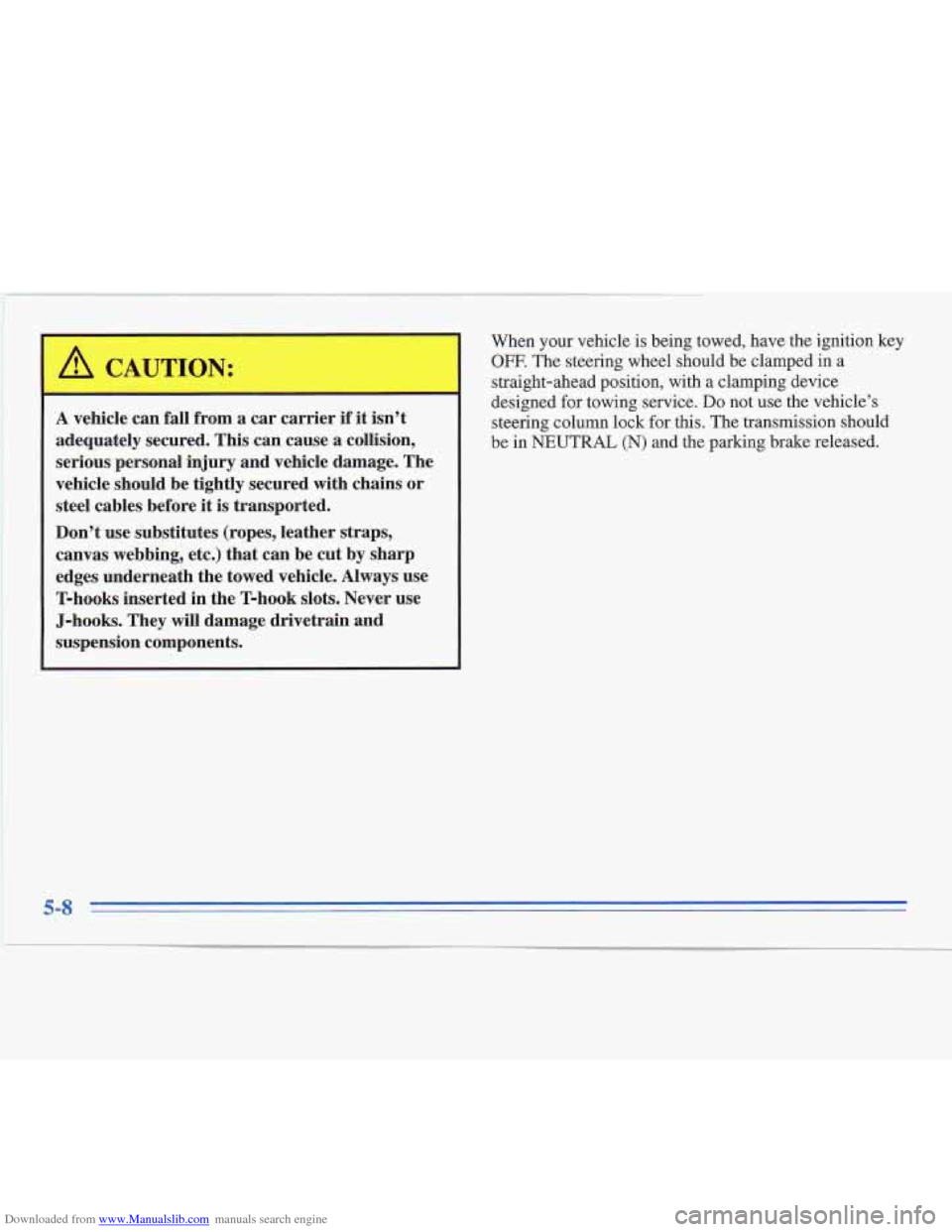
Downloaded from www.Manualslib.com manuals search engine A CAUTION:
A vehicle can fall from a car carrier if it isn’t
adequately secured. This can cause a collision,
serious personal injury and vehicle damage. The
vehicle should be tightly secured with chains
or
steel cables before it is transported.
Don’t use substitutes (ropes, leather straps,
canvas webbing, etc.) that can be cut
by sharp
edges underneath the towed vehicle. Always use
T-hooks inserted in the T-hook slots. Never use
J-hooks. They will damage drivetrain and
suspension components.
When your vehicle is being towed, have the ignition key
OFF. The steering wheel should be clamped in a
straight-ahead position, with a clamping device
designed
for towing service. Do not use the vehicle’s
steering column
lock for,this. The transmission should
be in
NEUTRAL (N) and the parking brake released.